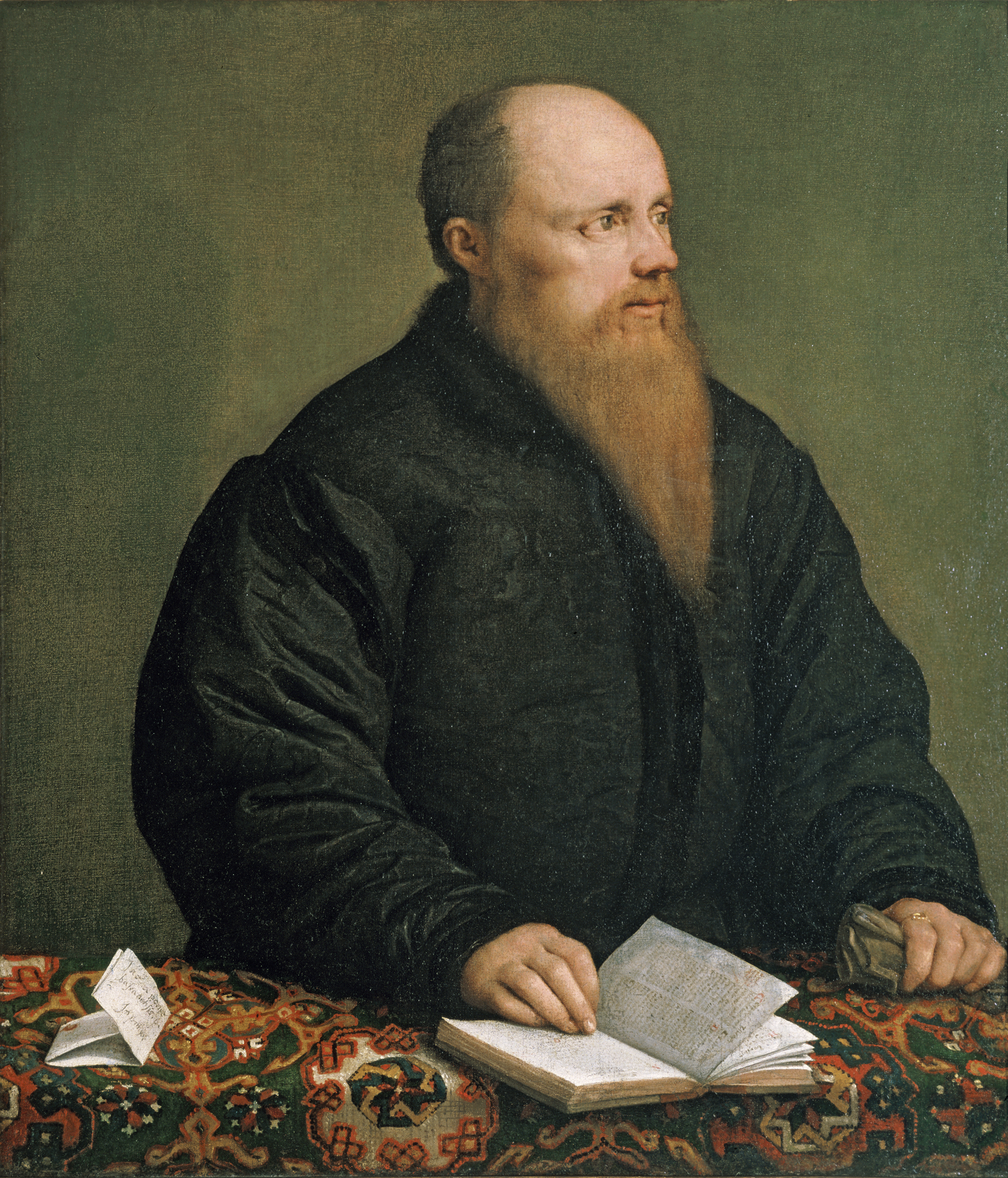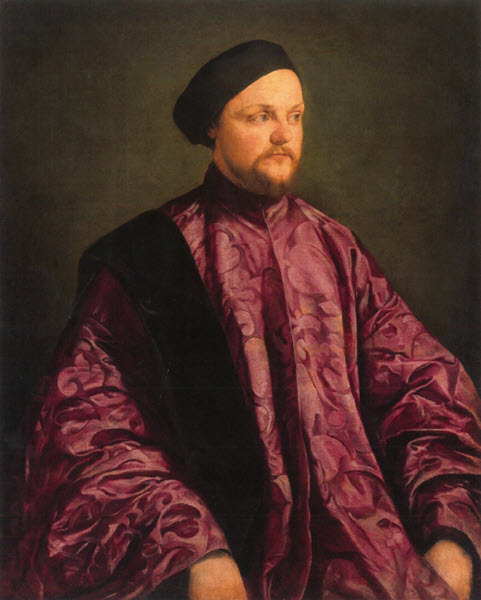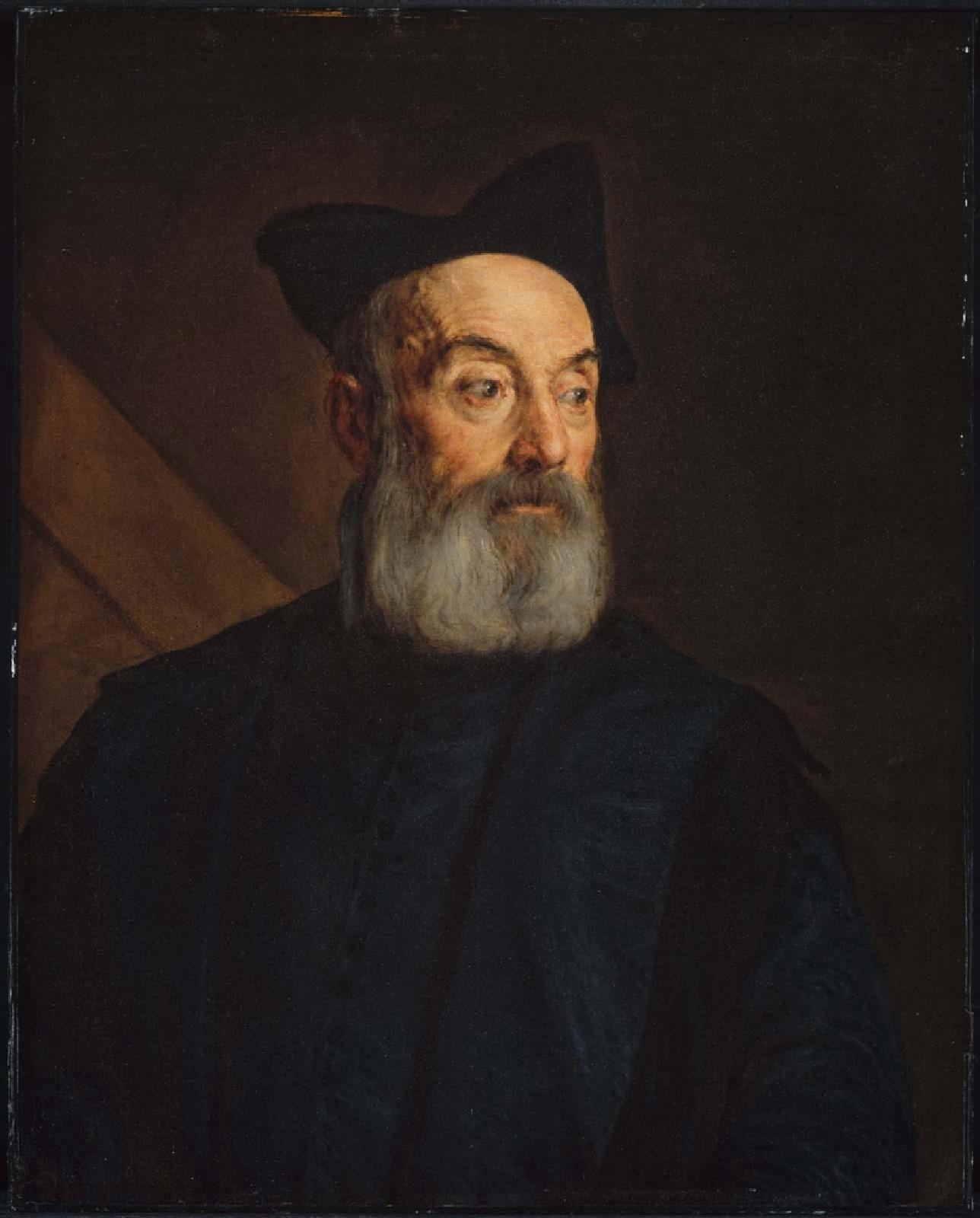Portrait of a Bearded Man (about 1550) is one of the very few portraits to survive from Jacopo Bassano’s mid-career, when he was also producing some of his most captivating religious and allegorical works, such as Lazarus and the Rich Man (about 1554, Cleveland Museum of Art) and Saint John the Baptist in the Wilderness (1558, Museo Civico, Bassano del Grappa), which combined dramatic lighting, unusual compositions, and an expressive naturalism in the description of human form.1 It depicts a middle-aged man with a high brow and long beard, who wears a voluminous black coat and casts a shadow on the olive-colored wall behind him. Despite the portrait’s austerity, with few obvious clues to the subject’s occupation or identity, Bassano imbues his sitter with a riveting emotional and psychological intensity. The man’s head turns to the left, as if something has caught his attention, and his tired and watery eyes exert a powerful pull on the viewer’s sympathies. As with nearly all of Bassano’s extant portraits, the circumstances of the commission are undocumented, but Bassano’s attentiveness to his subject’s comportment and dress capture something essential about his station, dignity and inner life. Moreover, the portrait’s intriguing stylistic qualities, in particular the kinetic twist of the sitter’s upper body and head, suggest that Bassano was experimenting with new approaches to portraiture in addition to the large-scale multi-figural works with which he is most closely associated.

Bassano has long been recognized as an accomplished portraitist, although scholars have struggled to reconstruct this facet of his career. In Le maraviglie dell’arte (1648), a compendium of the lives of the Venetian artists, Carlo Ridolfi (1594–1658) wrote that Bassano was “no less valued for his portraits,” which were “naturalistically rendered,” the artist “being accustomed to working from life.”2 The Bassano family’s account books, of which only one of four volumes survive, suggest that he completed portraits for a variety of sitters, including family members (Bartolomeo Merzari, the cousin of Jacopo’s wife, in 1544), local merchants (Lazzaro Guadagnini, involved in the textile trade in Bassano, in 1546), and other prominent residents of Bassano and its environs (a “dottor” Alessandro Campesan, in 1550, and the parish priest of Strigno, in 1545).3 None of these recorded portraits survive, and only one extant portrait, not documented in the surviving account book, contains his signature, his Portrait of a Man of Letters (about 1540), now at the Memphis Brooks Museum of Art (fig. 1). During the twentieth century, major exhibitions and monographs of Bassano’s work regularly revised his corpus of portraits, and W.R. Rearick, in the first study devoted exclusively to Bassano’s portraiture, in 1980, rejected all but three.4 Today, the handful of published portraits with firm attributions, such as his Portrait of a Venetian Senator (possibly Bernardo Morosini) (about 1540) in Kassel (fig. 2), and his Portrait of a Man (about 1576) in Boston (fig. 3), share several features: a cropped composition, loose, painterly brushstrokes, and the naturalistic rendering of his sitters’ facial features, achieving an exceptional depth and expressiveness.5 The Getty painting was added to Bassano’s corpus in 1971 by Alessandro Ballarin, who dated it to 1550 or shortly thereafter, primarily on stylistic grounds.6


The sitter appears to be someone of education and standing, perhaps an aging courtier, merchant, or man of letters. In the absence of attributes such as an inscription to help establish identity, the sitter’s costume and grooming assume greater significance. If this were a political or ecclesiastical figure of high rank, it is likely that Bassano would have portrayed him in his official vestments, as he did in the Kassel portrait, thought by some to be Bernardo Morosini, who served as Bassano’s podestá from 1541–1542.7 The sitter in that early portrait wears the sumptuous crimson robes typical of senators and high-ranking Venetian diplomats, and the shimmer of his draperies and their delicate leaf-shaped designs compete for attention with his refined features and confident gaze. By contrast, the garments in the Getty painting are more subdued, and yet they also operate to communicate the sitter’s status. The gentleman’s quilted jacket puffs out in the upper arms and shoulders, enhancing his corporeal presence, which is reinforced by the shadow he casts on the wall at left. The deep black of his garments, together with the absence of decorative detail, may suggest an aversion to color and adornment consistent with elite tastes of the mid-sixteenth century. Amedeo Quondam has tied the prevalence of black attire in sixteenth-century Italian portraiture to an emerging aesthetic and ethical system that valued minimalism and restraint.8 By donning black with little adornment, Bassano’s sitter signaled that he was a man of honor and good character. Moreover, while black attire had its own symbolic and suggestive associations, it also serves in the present portrait to draw attention, through contrast, to the sitter’s pale and soulful face. His twin-peaked brow, which mimics the vaulted curves of his eyebrows, accentuates his broad forehead, and the subtle hint of veins near his right temple links the object of his gaze to thought and reflection.
In addition to clothing, the sitter’s long beard is also worn in a manner designed to command esteem and respect. The whiskers above his mouth are trimmed and precise, while his sideburns are bushy, adding bulk to a relatively gaunt face. As it extends downward, the beard widens, then narrows into a well-defined point. In Italian society of this period, the style of beards ran the gamut, from the trimmed stubble of a young suitor to the whitened tangle of an elderly sage.9 This haircut — neatly cropped on top with a generous beard extending to the upper chest, reminiscent of the portrait busts of classical philosophers — was particularly popular in the mid-sixteenth century among Italian humanists and the clerical elite. Moreover, the unfussy style of the sitter’s beard is in keeping with the recommendations of the most influential arbiters of sixteenth-century courtly style and manners. In Il Cortegiano, Baldassare Castiglione’s discourse on etiquette and morality (Venice 1528), the assembled courtiers cautioned against paying too much attention to grooming lest they privilege appearance over inner qualities. To draw too much attention to the beard — or to clothing, boots or teeth, for that matter — was to be “very tasteless.”10 And in the Galateo (Venice 1558), the Florentine poet and writer Giovanni della Casa warned explicitly against being too adventurous with facial hair, lest one contravene local custom.11 Indeed, there is a striking resemblance between the beards worn by Bassano’s sitter and Jacopo da Pontormo’s portrait of a man identified for many years as della Casa himself (fig. 4).12

Bassano adopted a novel stylistic and compositional approach in this portrait, suggesting that it was produced at an important moment, creatively, in his career. In his early portraits, such as the Memphis and Kassel pictures (figs. 1 and 2), Bassano depicted his subjects in a standard three-quarter view, eyes directed to the sitter’s left. The Memphis portrait, dated to about 1540, is particularly archaic in format, positioning the sitter on a parapet, his fingers resting on a book. In the Getty portrait, by contrast, Bassano introduces a subtle twist of the body that extends through the sitter’s neck and head. The portrait has a dynamic energy, as if this man were still in movement, responding to an event outside of the frame.13 In the 1540s and 1550s, Bassano turned increasingly to graphic art for inspiration, which exposed him to contemporary approaches to painting elsewhere in Italy, including Florence and Parma.14 The present portrait resembles variations by Florentine mannerists, such as Francesco Salviati and Agnolo Bronzino, in which the sitter’s head turns in a direction opposite to that of the body.15 Moreover, Bassano’s large religious pictures during this period, such as The Way to Calvary (about 1552, Museum of Fine Arts, Budapest) and Lazarus and the Rich Man (about 1554, Museo Civico, Bassano del Grappa), show a fixation with elongated forms, elegantly intertwined, and an investigation through exaggeration of the way bodies curve and coil. In both portraiture and larger compositions, Bassano seems to have been exploring the expressive effects of combining physical movement and psychological pathos.
Given the scarcity of portraits by Bassano, it is perhaps not surprising that it entered the Getty collection with an attribution to Giovanni Battista Moroni, the northern Italian painter best known for his renderings of the local aristocracy and clergy. The painting’s earliest known provenance is in the collection of Cyril Flower, Esq., the 1st Baron of Battersea (1843–1907), as a “Venetian school” painting on loan to the Winter Exhibition in London in 1880.16 Upon the death of the Baron in 1907, the painting passed to his wife, Constance (1843–1931), daughter of Sir Anthony de Rothschild, and an undated photo shows the Getty portrait installed in one of the opulent rooms at Lady Battersea’s London residence.17 By that time, the painting had been attributed to Moroni,18 a reflection in part of late-nineteenth-century tastes in Northern Italian portraiture. The artists of northern Italy (from Bergamo, Brescia and other centers in the Po Valley), particularly Moroni and his teacher Moretto da Brescia, were coveted by British collectors in the mid-19th century, an interest driven in part by the Italian dealer Giovanni Morelli and Charles Eastlake, then Director of the National Gallery in London.19 Morelli fueled enthusiasm for Moroni and Moretto among the British delegation in northern Italy during the Risorgimento, and Eastlake and Otto Mündler, the National Gallery’s traveling agent, pursued works by the two artists in the 1850s, many of which now grace British collections. It is only as Bassano’s own portraiture came into focus that the significance of the Getty picture to Bassano’s oeuvre has emerged. The painting exemplifies how Bassano referenced and reinterpreted traditions outside of the mainland Veneto, adopting an economical yet expressive mode to convey his sitter’s station and status, as well as a suggestion of his inner life.
- David Bardeen
-
For an overview of Bassano’s career and stylistic development, see Beverly Louise Brown and Paola Marini, eds., Jacopo Bassano, c. 1510–1592, exh. cat. (Fort Worth: Kimbell Art Museum, 1993). ↩︎
-
“Fù egli non meno valoroso nel far de’ritratti, riducendoli al natural, essendo avvezzo à cavare le cose dal vivo …” C. Ridolfi, Le maraviglie dell’arte ovvero le vite degli illustri pittori veneti e dello stato descritti da Carlo Ridolfi (Venice, 1684), ed. D. von Hadeln (Berlin, 1914), vol. 1, p. 401. ↩︎
-
Brown and Marini 1993 (note 1), pp. 310-312, no. 25, entry by Paola Marini. The surviving account book was published by Michelangelo Muraro, Il Libro Secondo di Francesco e Jacopo dal Ponte (Bassano: G.B. Verci Editrice, 1992). ↩︎
-
W.R. Rearick, “The Portraits of Jacopo Bassano,” Artibus et Historiae 1, 1 (1980), pp. 99-114, which includes a summary and analysis of attributions of portraits to Bassano in exhibitions and publications during the twentieth century, including the 1957 exhibition at the Palazzo Ducale in Venice and the monograph by Edoardo Arslan, I Bassano (Milan: Casa Editrice Ceschina, 1960). ↩︎
-
For a discussion of Bassano’s portraiture, see Rearick 1980 (note 4). ↩︎
-
Alessandro Ballarin, “Un ritratto inedito del Bassano,” Arte Veneta XXV (1971), pp. 268-271. Ballarin based the attribution on a number of factors, including the way light pooled across the sitter’s face and beard, the unsparing description of the sitter’s aging face, and stylistic similarities to several of Bassano’s large religious paintings from this period. See Ballarin 1971 (note 6), pp. 269-270. ↩︎
-
Bastian Eclercy and Hans Aurenhammer, eds, Titian and the Renaissance in Venice, exh. cat. (Munich, London and New York: Prestel Verlag, 2019), pp. 166-167, no. 58, entry by Beverly Louise Brown. ↩︎
-
Amedeo Quondam, Tutti i colori del nero: Moda e cultura del gentiluomo nel Rinascimento (Vicenza: Angelo Colla Editore, 2007). See also Amedeo Quondam, “Tutti i colori del nero. Moda ‘alla spagnola’ e ‘migliiore forma italiana,’” in Giovanni Battista Moroni: Il Cavaliere in nero: L’imagine del gentiluomo nel Cinquecento (Milan: Skira Editore, 2005), pp. 25-45. ↩︎
-
Douglas Biow, On the Importance of Being an Individual in Renaissance Italy: Men, Their Professions, Their Beards (Philadelphia: University of Pennsylvania Press, 2015), pp. 195-196. ↩︎
-
Baldassare Castiglione, The Book of the Courtier, trans. Leonard Eckstein Opdycke (New York: Charles Scribner’s Sons, 1902), p. 104. For a discussion of beards and self-presentation in sixteenth-century Italy, see Biow 2015 (note 9), pp. 181-206. ↩︎
-
Giovanni della Casa, Galateo, trans. Konrad Eisenbichler and Kenneth R. Bartlett (Toronto: Centre for Reformation and Renaissance Studies, 1986), p. 12. For a discussion, see Biow 2015 (note 9), p. 193. ↩︎
-
Antonio Geremicca has argued that the sitter is not Giovanni della Casa, but instead the bishop and cardinal Niccoló Ardinghelli. Antonio Geremicca, “Pontormo, Ritratto di vescovo (Niccolò Ardinghelli?), 1541–1542 circa,” in eds. Carlo Falciani and Antonio Natali, Pontormo e Rosso Fiorentino: Divergenti vie della “Maniera” (Washington: National Gallery of Art, 2014), p. 136. ↩︎
-
Maria Elisa Avagnina, “Jacopo Bassano 1545–1555,” in eds. Brown and Marini 1993 (note 1), pp. 283-285. ↩︎
-
Brown and Marini 1993 (note 1), p. 283. ↩︎
-
See, for example, Salviati’s Portrait of a Man, about 1544–1548, Los Angeles, J. Paul Getty Museum, inv. no. 86.PB.476, https://www.getty.edu/art/collection/objects/786/francesco-salviati-portrait-of-a-man-italian-about-1544-1548/, and Bronzino’s Pierantonio Bandini, about 1550–55, Ottawa, National Gallery of Canada, inv. no. 3717. ↩︎
-
Exhibition of Works by the Old Masters, and by Deceased Masters of the British School, Including a Special Collection of Works by Holbein and His School, Winter Exhibition, Eleventh Year, exh. cat. (London: Royal Academy, with William Clowes and Sons, 1880), no. 129, p. 27. ↩︎
-
Email correspondence from Michael Hall (March 6, 2005), Paintings Department. ↩︎
-
Exhibition of Venetian Art, exh. cat. (London: The New Gallerly, 1894), no. 20, p. 5. ↩︎
-
John Fleming, “Art Dealing and the Risorgimento — I,” The Burlington Magazine 115, no. 838 (Jan. 1973), pp. 4-17; see also Hugh Brigstocke, “Giovanni Battista Moroni. A 400th Anniversary Exhibition at the National Gallery, London. Catalogue by Allan Braham,” Arte Lombarda, Nuova Serie, No. 51 (1979), pp. 93-97. ↩︎